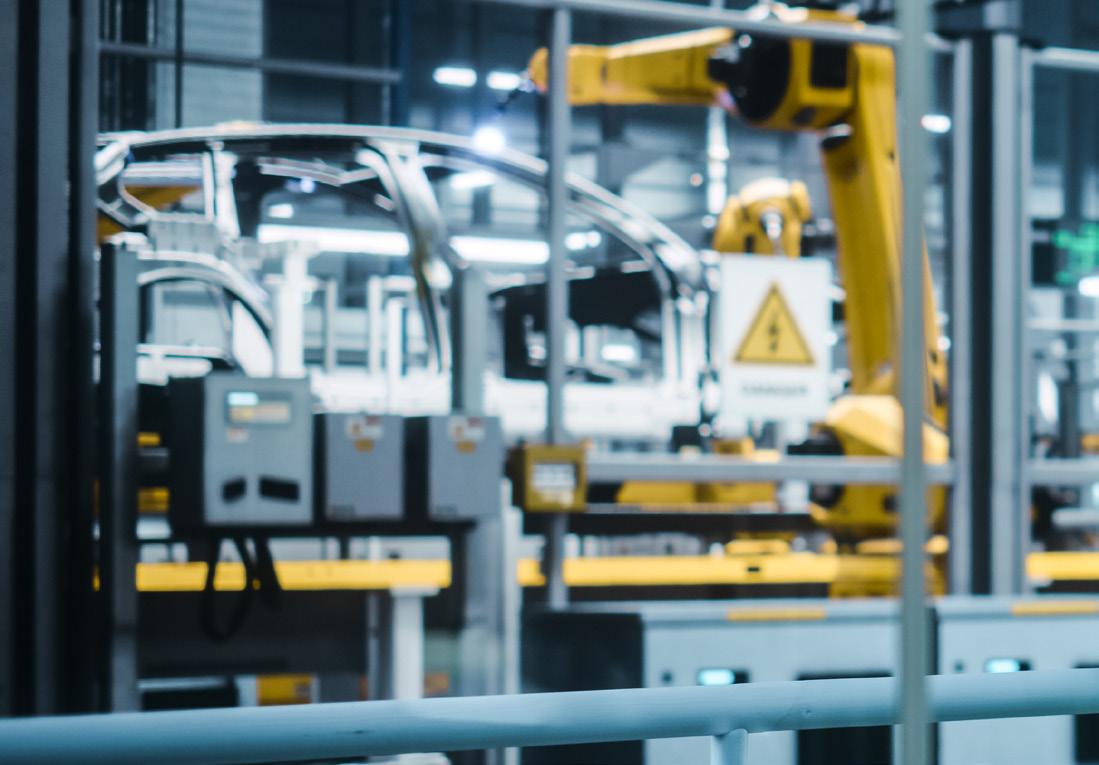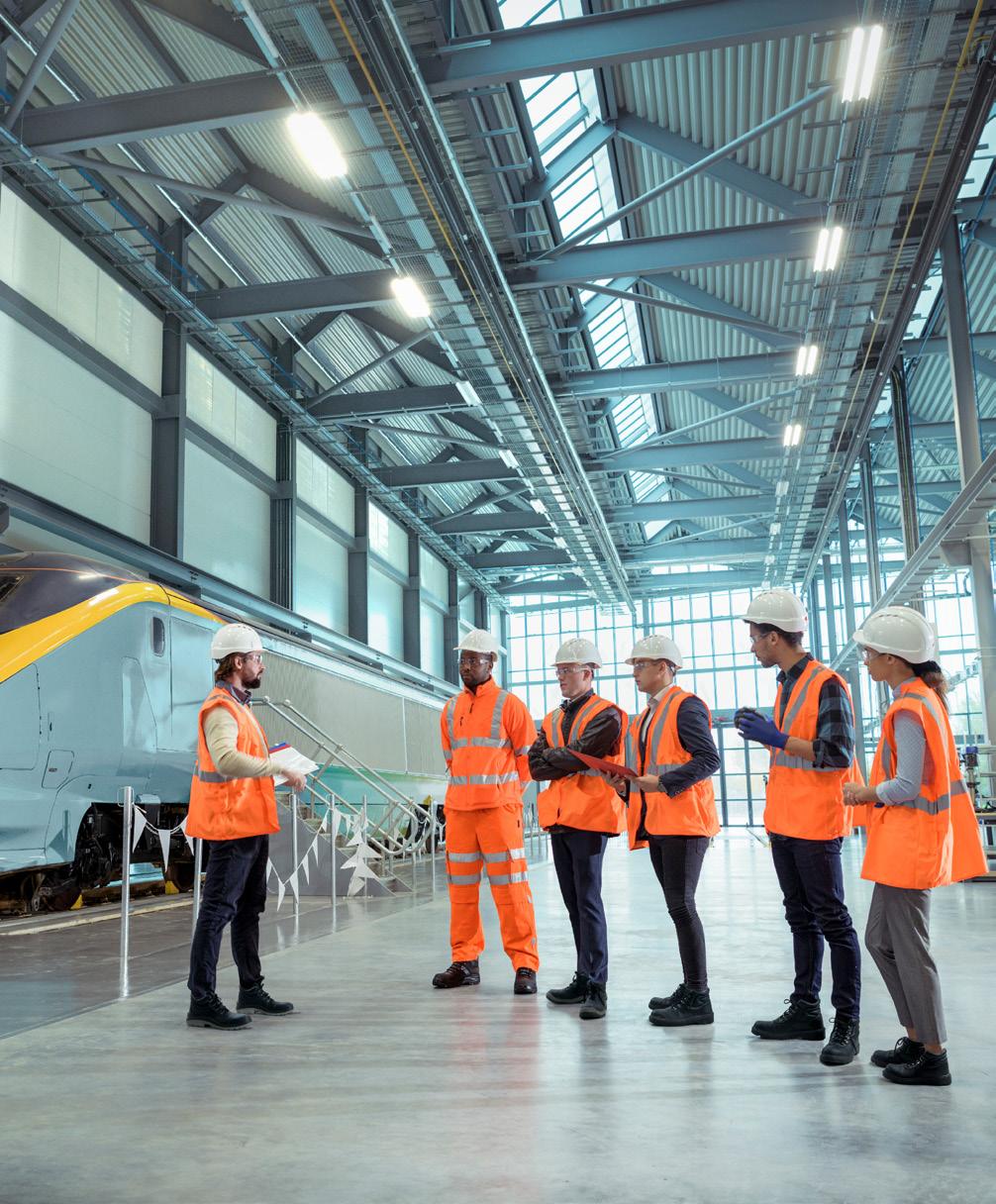The State of MAINTENANCE AND RELIABILITY in the UK

Research Partners




Research Partners


For 28 years the MAINSTREAM research team has engaged with Maintenance and Reliability leaders, to understand their collective obstacles and pain points (and opportunities), as they work towards achieving maintenance and reliability excellence and improving overall business performance.
These findings enable leaders, teams, and individuals to understand best practices, compare their companies’ performance and working environment to those inside and outside their industry, and make informed and effective decisions.
The top ten obstacles that have emerged throughout this report will be used to create the MAINSTREAM UK Summit Program.

• WORKFORCE CHALLENGE: 27% of UK maintenance engineers are over 55 years old, with 38% of technical specialists retiring within 5 years, while companies face an annual shortfall of 37,00059,000 engineering graduates – creating a critical skills gap at a time when both traditional mechanical skills and new digital capabilities are essential.
• DATA MANAGEMENT: UK asset-intensive industries typically use less than 27% of the data they collect for operational decision-making, with 67% of manufacturing companies citing data integration as a “significant barrier” to implementing predictive maintenance strategies.
• REACTIVE CULTURE: 83% of maintenance improvement initiatives fail to sustain results beyond 18 months due to insufficient attention to cultural factors, with 67% of UK maintenance organisations still tying monetary incentives to breakdown repair rather than failure prevention.
• STRATEGIC MISALIGNMENT: Only 24% of UK organisations have formal mechanisms to align maintenance objectives with corporate strategy, yet companies with integrated maintenance and business strategies achieve 27% higher return on assets than those with disconnected approaches.
• TECHNOLOGY ADOPTION: 58% of UK asset-intensive organisations have initiated but subsequently abandoned at least one AI-related maintenance project in the past three years, with organisations taking an average of 22 months to move from pilot to production – nearly twice the global average.
• C-SUITE SUPPORT: 76% of UK C-suite executives consider maintenance a “cost centre” rather than a “value creator,” contributing to UK companies allocating an average of 2.8% of asset replacement value to maintenance – below the global best practice benchmark of 3.5%.
• WORK MANAGEMENT FUNDAMENTALS: Maintenance schedule compliance averages just 68% across UK industries (compared to 85% best practice benchmark), with 47% of companies regularly deferring preventive maintenance, creating a cumulative maintenance deficit estimated at £27 billion.
• ‘FIREFIGHTING’ MAINTENANCE CYCLE: UK organisations spend 55% of maintenance budgets on reactive activities (compared to the global benchmark of 35%), costing the UK economy an estimated £23 billion annually in avoidable downtime despite evidence that organisations with less than 30% reactive maintenance experience 78% fewer unplanned production interruptions.
• DECARBONISATION IMPACT: 35% of the UK’s energy infrastructure assets will require substantial modification or replacement by 2035 to support decarbonisation, yet 62% of industrial companies report significant uncertainty about maintenance strategies for low-carbon technologies.
• KNOWLEDGE LOSS: UK industrial organisations lose an average of £240,000 in productivity per retiring maintenance specialist due to undocumented knowledge, yet only 22% have formal knowledge capture programs despite 78% identifying knowledge loss as a “significant business risk.”


This research draws on multiple sources to develop a comprehensive understanding of the state of maintenance and reliability in the United Kingdom and the obstacles preventing excellence:
1. Roundtable Discussions: Three facilitated 90-min roundtable discussions with maintenance and reliability professionals from diverse sectors, exploring their experiences and perspectives on key challenges.
2. Survey Responses: Analysis of survey data from 103 UK maintenance and reliability professionals identifying their most significant challenges and barriers to improvement.
3. Industry Documentation: Review of industry reports, case studies, and best practice guidelines related to maintenance and reliability in the UK context.
4. Expert Insights: Incorporation of perspectives from 30 one-on-one interviews with industry leaders and consultants.
The results of the survey directly influence the MAINSTREAM UK Summit program. This means that the speakers (local and international), workshops and masterclasses at the MAINSTREAM Summit on the 21st October 2025, will be relevant to the community’s knowledge, capability, and training requirements.
The comprehensive survey content presented in this report was meticulously designed, developed, and authored by the MAINSTREAM research team. As a leading research authority in the ANZ region, MAINSTREAM brings decades of collective experience and methodological rigour to this analysis. The authors acknowledge Certus Digital and Accruent for their invaluable partnership and support throughout this research initiative.
Thank you to the following organisations for participating:
AILSA RELIABILITY SOLUTIONS
ARCADIS
ARCHER DANIELS MIDLAND
ASSET ONE
ATS AUTOMATION
BAE SYSTEMS
BAKER HUGHES
BAKKAVOR GROUP
BALFOUR BEATY
BARINGA
BENTLEY MOTORS
BIOMARIN PHARMACEUTICAL
BP (UNITED KINGDOM)
BRITISH AMERICAN TOBACCO
BRITISH GAS
BRITISH GYPSUM
CENTRICA
COCA-COLA
CONTOURGLOBAL
CONVATEC
CYTIVA
DAK CONSULTING
DRAX GROUP
E.ON
ECOLAB
EDF ENERGY
FDB
FINSBURY FOOD GROUP
FUTURE BIOGAS
GA PET FOOD PARTNERS
GLAXOSMITHKLINE
HARBOUR ENERGY
HARSCO ENVIRONMENTAL
I-CARE RELIABILITY
JERSEY ELECTRICITY
JOHNSON MATTHEY
KERRY
MAG (AIRPORTS GROUP)
MONDELEZ UK LIMITED
NATARA GLOBAL
NATIONAL GAS
NATIONAL OILWELL VARCO
NETWORK RAIL
OCEANEERING
OCTOPUS ENERGY
OVO ENERGY
PREMIER FOODS
PRO RELIABILITY
ROLLS-ROYCE PLC
SCOTTISHPOWER
SEVERN TRENT
SSE
STENA DRILLING
SWIZZELS MATLOW LTD
THAMES WATER
THE FORCE
THE HEINEKEN COMPANY
TRANSPORT FOR GREATER MANCHESTER
TWO6 SERVICES LTD
UE SYSTEMS
UNITED UTILITIES
WOOD PLC

This report examines the current state of maintenance and reliability in the United Kingdom, highlighting the key challenges faced by organisations striving for excellence in maintenance and reliability management. Based on extensive research, including roundtable discussions with industry professionals across various sectors, this report identifies the primary obstacles preventing UK organisations from optimising their maintenance and reliability practices.
The UK’s maintenance and reliability landscape is characterised by ageing infrastructure, skills shortages, technological transitions, and increasing regulatory pressures. Organisations across manufacturing, utilities, energy, transportation, and other asset-intensive sectors are grappling with similar challenges despite their different operational contexts.
These sectors form the backbone of the national economy. The effectiveness with which maintenance and reliability are managed directly impacts economic productivity, service reliability, and environmental sustainability. As such, the obstacles to achieving excellence in maintenance and reliability represent not just organisational challenges but strategic concerns for the UK’s industrial competitiveness and infrastructure resilience.
Our research reveals that the most significant barriers to maintenance and reliability excellence include workforce development issues, reactive maintenance cultures, data management complexities, declining work management fundamentals, cultural resistance to change, misalignment between maintenance strategies and corporate strategies, inadequate C-suite support, technological adoption challenges, decarbonisation pressures and institutional knowledge loss.
The UK maintenance and reliability sector faces a critical workforce challenge characterised by an ageing demographic, skills shortages, and rapidly evolving job requirements. Many older members of the community are leaving. Organisations are struggling to attract new talent, never mind top talent. So how are they going to cope with this transition, while at the same time they’re confronted with one of the most significant workforce challenges ever faced. The increase in automation and decarbonisation and climate targets reshaping the landscape of future job roles and required skill sets. Organisations must become more imaginative in their strategies to overcome these challenges.
Data management and utilisation challenges span collection, quality, integration, and analytical capabilities. The ability to accumulate data has increased over recent years due to advances in digital technology, improved monitoring capability and ever-expanding fields within maintenance and reliability systems and data bases. Organisations not only struggle with the volume of data, but also consolidating the data from disparate systems, and then transforming it into actionable insights that foster organisational change and lead to more advanced discussions and decision-making.
A concerning trend across UK asset-intensive organisations is the erosion of foundational work management practices. This decline threatens to
undermine more advanced asset management initiatives by weakening the essential operational processes upon which they depend. We must get back to basics, understand and adhere to maintenance planning, reporting, scheduling, work execution, spares management, and performance assessment and management. Compounding the situation, the declining integrity of maintenance work is leading to a deterioration in asset condition and health.
A significant obstacle to maintenance and reliability excellence in the UK is the frequent disconnect between asset management approaches and broader organisational objectives. This misalignment prevents organisations from optimising their asset investments and activities to deliver maximum business value. Maintenance and Reliability leaders are asked to articulate and define value contribution from investment. This is complex as there is not a simple linear relationship to value, and organisations have different perceptions of what value is as it pertains to their strategic needs.
UK maintenance and reliability professionals consistently struggle to gain executive-level support and adequate funding for their initiatives. While experts in equipment reliability, there is often a mismatch in articulating ROI, risk mitigation, and strategic advantages in the financial language that drives executive decision-making and budget allocation. This challenge reflects both communication barriers and competing priorities at the highest organisational levels.
The human and organisational aspects of maintenance and reliability present some of the most persistent challenges. Cultural barriers and change resistance frequently undermine otherwise well-designed improvement initiatives. In many organisations there remains a struggle with entrenched reactive maintenance cultures where breakdown heroes are celebrated while prevention is undervalued. Organisational silos, leadership turnover (averaging 3.2 years), and poor stakeholder alignment undermine improvement efforts, with 83% of initiatives failing beyond 18 months. Most companies still incentivise reactive work. Companies with collaborative cultures achieve higher OEE, yet most lack the change management capabilities to transform these deeply embedded cultural barriers.
Never has there been more technological options for maintenance and reliability practices, with artificial intelligence and other advanced capabilities promising transformation but often delivering mixed results. Technological breakthroughs in asset management are reshaping maintenance and reliability paradigms. In most cases, we need to respectfully temper the enthusiasm for the next shiny object and focus on getting bang-for-your buck or solving a pressing business need. It was generally agreed that great use cases and good business outcomes are the exception rather than rule.
The UK’s commitment to net zero carbon emissions by 2050 creates profound challenges for asset-intensive organisations, requiring fun -
damental rethinking of asset strategies, technologies, and capabilities. It’s a once in history challenge. Maintenance and reliability leaders are essential in helping organisations navigate the transition to a more sustainable and climate-resilient future. We need to create a skillbase that can cope with modern technologies while complying with a changing regulatory land scape in the context of decarbonisation and aggressive targets.
With 27% of UK maintenance engineers over 55 and 38% of technical experts retiring within 5 years, organisations face critical knowledge loss costing £240,000 per departing specialist. Despite most organisations recognising this risk, very few have formal knowledge transfer programs. Specialised knowledge takes a long time to develop. Organisations often resort to rehiring retirees, as ageing assets’ history exists primarily in workers’ memories, threatening £87 billion in infrastructure assets.
UK organisations struggle to break free from reactive maintenance cycles despite clear evidence supporting proactive approaches. Production pressures, resource limitations, and accumulated backlogs create perpetual firefighting, while organisational culture celebrates breakdown heroes rather than preventative work. The transition to proactive maintenance faces significant barriers: difficulty quantifying avoided failures, insufficient planning capabilities, resistance to methodologies like RCM, and limited data for predictive modelling. This reactive pattern both causes and reflects deeper asset management limitations across British industry.
The UK maintenance and reliability sector faces a critical workforce challenge characterised by an ageing demographic, skills shortages, and rapidly evolving job requirements. Many older members of the community are leaving. Organisations are struggling to attract new talent, never mind top talent. So how are they going to cope with this transition, while at the same time they’re confronted with one of the most significant workforce challenges ever faced. The increase in automation and decarbonisation and climate targets reshaping the landscape of future job roles and required skill sets. Organisations must become more imaginative in their strategies to overcome these challenges.
The maintenance workforce in the UK is experiencing significant demographic pressures:
• Many organisations report that experienced technicians and engineers are approaching retirement age, with some sectors seeing up to 30% of their workforce eligible for retirement within the next five years.
• Recruitment of skilled technicians is becoming increasingly difficult, with competition for talent intensifying across sectors.
“Recruitment of good time-served engineers is a real challenge”
• According to Engineering UK’s 2023 report, the UK faces an annual shortfall of between 37,000 and 59,000 engineering graduates and technicians to meet projected demand, with maintenance roles particularly affected.
• The Institution of Engineering and Technology (IET) Skills Survey found that 64% of UK engineering employers report difficulties in recruiting candidates with the right skills, representing a 5% increase from the previous year.
• Office for National Statistics (ONS) data reveals that 20.8% of the UK’s skilled maintenance workforce is over 55 years old, compared to the national average of 19% across all sectors.
• The UK Commission for Employment and Skills reports that 43% of vacancies in the maintenance sector are classified as “hard to fill” due to skills shortages.
• A government-backed review of industrial digitalisation, “Made Smarter,” estimated that the UK needs 175,000 more engineers and technicians with digital skills by 2030 to remain competitive.
• Our research shows that in Ireland, which faces similar workforce challenges, there is a very young workforce demographic and near full employment with only 3.5% unemployed. This makes people expensive to find, hire and retain.
The skill profile required for maintenance professionals is transforming rapidly:
• Traditional mechanical and electrical skills remain essential but are no longer sufficient.
• Digital literacy, data analysis capabilities, and familiarity with automation technologies are becoming fundamental requirements.
• The integration of IoT sensors, AI-based predictive maintenance, and advanced
64% of UK engineering employers report difficulties in recruiting candidates with the right skills

I’ve been to factories where we’ve had to bring people out of retirement because they’re the only ones who knew where these cables ran to and what they actually feed.
analytics is creating demand for hybrid skill sets that combine technical engineering knowledge with data science capabilities.
The transition from retiring professionals to new workforce entrants presents knowledge management challenges:
• Institutional knowledge about assets, especially older ones with limited documentation, often resides in the experience of long-serving staff.
• Formal knowledge transfer mechanisms are often inadequate or non-existent.
“We need to make maintenance sexy again”
UK organisations face specific hurdles in attracting and retaining maintenance talent:
• Competition with technology sectors for engineering and data science graduates.
• Perception issues around careers in maintenance and reliability.
• Salary expectations are increasing, creating a “bidding war” for experienced technicians.
Current approaches to workforce development show significant limitations:
• Apprenticeship programs, while experiencing a recent resurgence, face quality and consistency challenges.
• Technical education pathways often lack clear progression routes into advanced maintenance and reliability roles.
• In-house training frequently focuses on immediate technical needs rather than longterm capability development.
• Multi-skilling initiatives can lead to breadth without depth, creating “jack of all trades, master of none” outcomes.
Our supplementary research reveals that in many maintenance organisations:
• Heads of Reliability and Heads of Engineering take on numerous additional responsibilities not core to their primary functions.
• Leaders are overwhelmed with work and job scope creep, starting with clear job descriptions that become murky over time.
• The definition of roles like Reliability Engineering is often unclear and confusing, with companies frequently conflating it with simply chasing quality deficiency or condition monitoring.
• True Reliability Engineers should be focusing on Reliability in Design, Operations, Planning, Procurement and Maintenance, as well as reliability modelling and lifecycle management from cradle to grave.
The workforce challenge represents a fundamental constraint on the UK’s maintenance and reliability capabilities. Without adequate human resources possessing the right combination of technical, analytical, and digital skills, organisations will struggle to implement more advanced maintenance and reliability practices regardless of technological investments or strategic ambitions.
Data management and utilisation challenges span collection, quality, integration, and analytical capabilities. The ability to accumulate data has increased over recent years due to advances in digital technology, improved monitoring capability and ever-expanding fields within maintenance systems and data bases. Organisations not only struggle with the volume of data, but also consolidating the data from disparate systems, and then transforming it into actionable insights that foster organisational change and lead to more advanced discussions and decision-making.
“We have a real weird combination of bringing in some new technology, but we’ve got a legacy of 40 years’ worth of data that’s been collected on paper.”
Organisations face significant hurdles in gathering reliable maintenance data:
• Geographic dispersion of assets creates logistical challenges for data collection, particularly in sectors like utilities and transportation.
• Legacy assets often lack digital monitoring capabilities, requiring manual data collection.
• Field technicians may prioritise repair work over data recording, leading to incomplete maintenance histories.
• The UK Government’s Infrastructure and Projects Authority (IPA) reports that poor asset data quality contributes to approximately £2.5 billion in additional costs annually across national infrastructure projects.
• According to IBM’s UK Data Readiness Assessment, only 23% of UK industrial organisations believe their asset data is fully ready for advanced analytics applications.
• Ofwat’s PR24 regulatory framework for water utilities explicitly highlights data quality as a key concern, with £200 million allocated specifically for improving asset data collection and management in the 2025-2030 period.
• The Digital Catapult’s 2023 survey found that 67% of UK manufacturing companies cite data integration as a “significant barrier” to implementing predictive maintenance.
• Network Rail’s Digital Railway Programme identified that improving data quality could reduce maintenance costs by 15-20%, representing approximately £300 million in annual savings across the UK rail network.
• A 2023 study by the Institute for Manufacturing found that UK assetintensive industries typically use less than 27% of the data they collect for operational decision-making.
The biggest challenge we have is capturing the relevant data at the right time. We often have too much data or not enough to make a meaningful decision.

23% of UK industrial organisations believe their asset data is fully ready for advanced analytics applications
Data quality issues undermine confidence in maintenance information:
• Inconsistent data entry standards and terminology create confusion.
• Missing or inaccurate asset information compromises decision-making.
• Manual transcription from field notes to digital systems introduces errors and delays.
The fragmentation of maintenance information across multiple systems presents integration difficulties:
• Many organisations operate with a patchwork of legacy systems, modern applications, and manual processes.
• Data silos prevent holistic equipment visibility and coordinated decisionmaking.
• Incompatible data formats and structures complicate cross-system analysis.
Organisations struggle to derive actionable insights from their maintenance data:
• There’s often a proliferation of dashboards and reports without corresponding analytical depth.
• Skills shortages in data analysis specifically oriented toward maintenance and reliability.
• Difficulty in connecting condition data to failure prediction and maintenance optimisation.
”We have more Power BI dashboards than we have major assets.”
New data technologies face implementation challenges:
• Connectivity limitations in industrial environments hinder real-time data collection.
• Cost justification for advanced monitoring and analytics remains challenging.

• Uncertainty about which technological approaches will deliver sustainable value.
Fundamental data architecture problems complicate maintenance information management:
• Inconsistent naming conventions and hierarchies across assets and sites.
• Lack of industry-wide standards for maintenance data structures and interchange formats.
• Limited use of reference data models to support consistency and comparability.
“The taxonomy has to be really, really good in terms of your naming convention for your parts, because if it’s not, it can create absolute chaos.”
Our research highlights some practical examples of data challenges:
• Most companies reported struggling with
data transfer issues in remote regions with poor connectivity when implementing condition-based maintenance programs.
• Manufacturing organisations often face difficulty collecting and integrating data across multiple sites, especially when dealing with acquisitions and legacy systems.
• A multi-site manufacturer reported issues with below-ground assets mastered in GIS and above-ground assets in their ERP, creating integration challenges.
Data-related challenges form a significant barrier to advanced maintenance and reliability practices in the UK. Without reliable, integrated, and analysable maintenance information, organisations cannot effectively implement condition-based maintenance, predictive analytics, or risk-optimised maintenance investment planning. The journey from data collection to genuine insight remains challenging for many UK maintenance and reliability managers.
A concerning trend across UK asset-intensive organisations is the erosion of foundational work management practices. This decline threatens to undermine more advanced maintenance and reliability initiatives by weakening the essential operational processes upon which they depend.
Fundamental planning and scheduling processes show signs of deterioration:
• Incomplete job plans with insufficient detail on tasks, tools, parts, and safety requirements.
• Inadequate time allocation for maintenance activities leading to rushed work execution.
• Schedule compliance metrics often receive insufficient attention as performance indicators.
“Planning and scheduling can be challenging when trying to break through a reactive maintenance culture.”
• MAINSTREAM’s Maintenance and Reliability’s 2025 UK Benchmarking Study found that maintenance schedule compliance averages just 68% across UK asset-intensive industries, well below the 85% considered best practice.
• The UK Health and Safety Executive (HSE) reported that inadequate maintenance planning contributed to 23% of serious industrial incidents in 2021-2022, up from 18% in the previous reporting period.
• According to the Society of Operations
Engineers, 47% of UK manufacturing and utility companies admit to regularly deferring preventive maintenance due to operational pressures, creating a cumulative maintenance deficit estimated at £27 billion.
• A joint study by the University of Manchester and the Manufacturing Technology Centre revealed that 58% of UK maintenance professionals report deterioration in maintenance planning quality over the past five years.
• The Office for Nuclear Regulation’s annual report cited work management deficiencies as a “recurring theme” in compliance issues, with incomplete job plans featuring in 40% of maintenance-related regulatory findings.
• MAINSTREAM’s Reliability and Maintenance Benchmarking study’s latest data shows that UK organisations spend 41% of their maintenance budgets on reactive work, compared to a global best practice target of 20%.
Maintenance documentation practices exhibit quality concerns:
• Incomplete work order closure information limiting the value of maintenance history.
• Inconsistent failure coding undermining reliability analysis.
• Limited root cause analysis documentation to support continuous improvement.
“The volume of reactive work and duplication of work in CMMS makes it hard to properly assess work prior to scheduling.”
23% of serious industrial incidents in 20212022 indicate inadequate maintenance planning as a contributing factor

Our biggest challenge is finding balance in repairing known faults and preventative tasks within the schedule.
Spare parts control and management face significant operational issues:
• Inventory record accuracy problems leading to unexpected stockouts.
• Informal local parts caches outside the official inventory system.
• Inconsistent part numbering and descriptions hampering identification and cross-referencing.
• Limited standardisation of components across similar assets increasing inventory complexity.
“We’ve gone to sites and offered the service to walk the engineering stores, look at the inventory levels that you actually have versus what you have on the systems. And I’d say 100% of the time, we’re finding discrepancies.”
Maintenance strategy execution shows disconnects between design and practice:
• Preventive maintenance routines performed as checklist exercises rather than thorough inspections.
• Limited adjustment of maintenance frequencies based on equipment condition or performance.
• Weak connections between condition monitoring data and maintenance action.
Technical execution of maintenance work reveals concerning patterns:
• Quality variations in similar maintenance tasks across different technicians.
• Limited application of precision maintenance techniques.
• Inconsistent use of predictive technologies like vibration analysis or thermography.
“We actually recognise that some of the engineers that were going out carrying out some of the corrective work were installing bearings on the wrong way.”
Work control processes show signs of circumvention and variability:
• Inconsistent adherence to defined maintenance procedures.
• Informal work execution outside the official work management system.
• Safety permit and isolation procedures not always followed rigorously.
• Limited post-maintenance testing to verify work quality.
Our research reveals additional concerning practices:
• Some small manufacturers report operating with a run-to-failure maintenance approach combined with no spare parts inventory.
• Lack of Computerised Maintenance Management Systems (CMMS) in many organisations.
• Process safety concerns directly resulting from equipment failures and inadequate maintenance.
• Outdated or missing asset registers and criticality analyses, even in larger organisations with multiple facilities.
The decline in work management fundamentals has direct consequences for equipment health and reliability. Without robust execution of these foundational processes, organisations cannot build sustainable improvement in maintenance performance regardless of strategic or technological initiatives.
The human and organisational aspects of maintenance and reliability present some of the most persistent challenges for UK organisations. Cultural barriers and change resistance frequently undermine otherwise well-designed improvement initiatives.
A deeply entrenched reactive maintenance mindset prevails in many organisations:
• Glorification of breakdown response as heroic while preventive work receives limited recognition.
• Performance metrics and incentives that reinforce reactive behaviours.
• The UK Government’s Industrial Strategy Council reported that organisational culture was cited as the primary barrier to maintenance and reliability improvement in 72% of surveyed companies, far exceeding technology or financial constraints.
• A study by the Chartered Institute of Personnel and Development (CIPD) found that 67% of UK maintenance organisations tie monetary incentives to breakdown
repair rather than failure prevention, reinforcing reactive behaviours.
• According to MAINSTREAM UK’s Maintenance and Reliability Report, 83% of maintenance improvement initiatives fail to sustain results beyond 18 months due to insufficient attention to cultural and behavioural factors.
• The UK Manufacturing Technology Centre’s research indicates that leadership changes disrupt 58% of maintenance improvement programs, with the average tenure of senior maintenance leaders at just 3.2 years – shorter than most transformation initiatives require.
• A study by the Institute of Mechanical Engineers found that UK organisations with strong collaborative cultures between operations and maintenance achieved 22% higher Overall Equipment Effectiveness (OEE) than those with siloed approaches.
• The Nuclear Industry Association’s benchmarking program identified that only 31% of UK organisations effectively measure and reward proactive maintenance behaviours, compared to 67% in highreliability sectors globally.
Engineers see themselves as breakdown engineers as opposed to being proactive. Trying to shift that is extremely difficult.

Cross-functional barriers impede collaborative maintenance and reliability:
• Limited communication between operations, maintenance, engineering, and finance functions.
• Conflicting priorities and performance measures between departments.
• Incomplete understanding of how different functions contribute to equipment performance.
“Our team members don’t work together. They’re not on the same page. They don’t understand each other’s perspectives”.
New maintenance and reliability approaches face significant implementation challenges:
• Scepticism toward reliability-centred maintenance and other advanced methodologies.
• Limited patience for improvement programs that require sustained effort before showing results.
Discontinuity in leadership undermines sustained improvement efforts:
• Difficulty balancing short-term production demands with long-term reliability improvement activities.
• Frequent changes in management direction disrupt long-term maintenance and reliability initiatives.
• One energy sector professional commented: “The main challenge for us is, like, I say it’s around having a little bit of consistency with management and having the same sort of strategies.”
• Leaders see RCM to be consuming vast amounts of resource with very little sort of payback.
• Difficulty maintaining momentum through leadership transitions. 31% of UK organisations effectively measure and reward proactive maintenance behaviours
• New leaders often bring different priorities and approaches, disrupting ongoing programs.
Securing and maintaining broad organisational support proves difficult:
• Limited engagement from senior leadership in maintenance and reliability improvement.
• Difficulty demonstrating early wins to build and maintain support.
• Competing organisational priorities diverting attention and resources.
“If you don’t have a real strong stakeholder commitment, quite often these proactive elements fail.”
Organisations often lack effective change management capabilities:
• Limited structured approach to implementing maintenance and reliability changes.
• Insufficient attention to communication, training, and reinforcement.
• Failure to address personal impacts of change on affected staff.
• Inadequate measurement of change adoption and effectiveness.
“The underpinning theory of what makes a good maintenance strategy is well understood. However, challenges still exist around actually making sure that frontline maintenance managers understand that theory.”
Our supplementary research identified a three-stage roadmap that successful organisations follow to break the reactive maintenance culture:
1. From Continuous Improvement to Focused Improvement
• Initially, people focus on solving the top 3 problems they see today
• Evolution to “Focused Improvement” involves choosing a specific outcome and driving toward it (e.g., improving breakeven point by 25% to survive)
2. Production Supervisors Become Production Leaders
• Driving alignment and task transfer
• When operations supervisors move their horizons from “this shift” to “this month,” this becomes a catalyst for improvement
• A medium-term focus is the first key indicator of cultural change
3. Maintenance Focus Shifts from Preventing Downtime to Preventing Defects
• The development of operator-led reliability and plant care frees engineers to do value-adding project work
• The maintenance mindset shifts from extending time between failures to extending time between interventions
Cultural and change management challenges represent fundamental barriers to maintenance and reliability improvement in the UK. Without addressing these human factors, technical and strategic initiatives are unlikely to deliver sustainable results.
A significant obstacle to maintenance and reliability excellence in the UK is the frequent disconnect between maintenance and reliability approaches and broader organisational objectives. This misalignment prevents organisations from optimising their maintenance investments and activities to deliver maximum business value.
Maintenance and reliability often operate in isolation from corporate strategy:
• Limited input from maintenance and reliability professionals into business planning processes.
• Getting maintenance and reliability embedded into the culture and encouraging maintenance intelligence (data/information) dependent decision making remains a key challenge.
• Difficulty translating business goals into specific equipment performance requirements.
• Separate planning cycles for business strategy and maintenance activities.
• MAINSTREAM’s Maintenance and Reliability’s survey found that only 24% of UK organisations have formal mechanisms to align maintenance objectives with corporate strategy, despite recognised best practices requiring such alignment.
• The UK National Infrastructure Commission’s 2022 report highlighted that strategic misalignment contributes to an estimated £3.7 billion annually in suboptimal
maintenance investments across regulated infrastructure sectors.
• Research by the University of Cambridge’s Centre for Smart Infrastructure and Construction revealed that 63% of UK asset-intensive organisations acknowledge a disconnect between their corporate planning horizons (typically 1-3 years) and their equipment lifespans (often 20+ years).
• According to MAINSTREAM UK Maintenance and Reliability research, only 18% of maintenance managers regularly participate in corporate strategic planning sessions, limiting their input into business direction.
• The Department for Business, Energy and Industrial Strategy (BEIS) found that companies with integrated maintenance and business strategies achieved 27% higher return on assets than those with disconnected approaches.
• A UK Treasury review of infrastructure investment identified that public sector organisations with aligned maintenance and organisational strategies delivered capital projects with 24% less whole-life cost than those with fragmented approaches.
Different perspectives on asset value create strategic confusion:
• Finance functions typically focus on asset book value and depreciation.
• Operations emphasise asset availability and performance capacity.
• Maintenance prioritises reliability and life cycle cost.
18% of maintenance managers regularly participate in corporate strategic planning sessions

The term ‘gold standard’ or ‘world class’ limits thinking on what the business needs to achieve excellence.
Capital allocation processes often fail to optimise maintenance outcomes:
• Short-term financial metrics driving decisions that increase long-term equipment risks.
• Limited consideration of whole-life costs in investment decisions.
• Difficulty quantifying risk reduction benefits from proactive maintenance investments.
“Buy in from leadership teams and their lack understanding of the ROI for maintenance investments remains problematic”.
Performance metrics rarely connect maintenance activities to business outcomes:
• Asset performance measured in technical terms (availability, reliability) without clear links to business impact.
• Limited understanding of how maintenance metrics affect customer experience, cost position, or competitive advantage.
• Siloed reporting that fails to show crossfunctional dependencies in equipment performance.
Different time perspectives create strategic tension:
• Corporate planning typically operates on quarterly and annual cycles.
• Maintenance and reliability management requires multi-year and even multi-decade perspectives.
• Difficulty balancing short-term business needs with long-term equipment health requirements.
Organisational structures often inhibit strategic alignment:
• Limited maintenance and reliability representation in senior leadership forums.
• Fragmented responsibilities for equipmentrelated decisions across multiple functions.
• Inadequate mechanisms to resolve conflicts between operational, financial, and technical perspectives.
“A solution that many manufacturing organisations are beginning to turn to when it comes to maintenance is outsourcing, which can further complicate strategic alignment.”
• In regulated industries like government utilities, maintenance excellence improvement plans typically run for 5-year cycles because they are funded in 5-year regulatory periods.
• Manufacturing faces unique strategic alignment challenges compared to heavy asset industries (like Mining and Oil & Gas) due to the pace of operations and higher costs of downtime.
• One auto manufacturer reported a 99.5% uptime metric (only 6.5 minutes per day of allowed downtime), creating extreme pressure on maintenance strategies.
• The UK is described as particularly costconscious compared to other regions, making it harder to promote proactive maintenance despite long-term benefits.
• Benchmarking against standards like ISO 55000 and ISO 55001 is being used by some organisations to drive maturity and standardisation in maintenance strategies.
Strategic misalignment represents a fundamental barrier to maintenance and reliability excellence. Without clear connections between business objectives and maintenance strategies, organisations cannot optimise their maintenance investments and activities to deliver maximum business value.
UK maintenance and reliability professionals consistently struggle to gain executive-level support and adequate funding for their initiatives. This challenge reflects both communication barriers and competing priorities at the highest organisational levels.
Technical maintenance and reliability concepts often fail to resonate with executive decision-makers:
• Difficulty articulating the business value of reliability improvements.
• Limited ability to connect technical metrics to financial outcomes.
• Complex value chains between maintenance interventions and business performance.
• A survey by the Chartered Institute of Management Accountants (CIMA) found that 76% of UK C-suite executives consider maintenance a “cost centre” rather than a “value creator,” influencing investment decisions.
• The UK Institute of Directors reports that only 23% of board members in assetintensive companies have engineering or technical backgrounds, creating communication barriers for maintenance and reliability professionals.
• According to research by EY, UK companies allocate an average of 2.8% of asset replacement value to maintenance –
below the global best practice benchmark of 3.5% – reflecting difficulties in securing adequate funding.
• The UK’s Management Consultancies Association found that only 32% of maintenance improvement business cases successfully translate technical outcomes into financial language that resonates with CFOs.
• The 2025 MAINSTREAM Research study revealed that UK manufacturing companies that increased maintenance budgets by just 1% of asset value achieved an average 3.8% increase in production output – yet 68% of maintenance leaders report difficulties securing such investments.
• The British Standards Institution (BSI) estimates that UK organisations implementing maintenance best practices typically secure 14% more capital funding for asset investments than noncertified peers, demonstrating the value of formalised frameworks in executive communications.
Maintenance and reliability initiatives face intense competition for limited financial resources:
• Growth initiatives typically prioritised over equipment maintenance or renewal.
• Difficulty demonstrating quick returns from reliability investments.
• Incremental funding approaches limiting the scale and impact of improvement programs.
23% of board members in asset-intensive companies have engineering or technical backgrounds

Maintenance and reliability practitioners are asked to articulate and define value contribution from investment. This is complex as there is not a simple linear relationship to value, and organisations have different perceptions of what value is as it pertains to their strategic needs.
Asset risk exposures are frequently underappreciated at executive levels:
• Limited executive understanding of technical equipment risks and their business implications.
• Difficulty quantifying the probability and impact of equipment failures.
• Tendency to discount low-probability, highimpact failure scenarios.
Return horizons for maintenance investments often exceed executive attention spans:
• Executive incentives typically aligned to short-term performance.
• Benefits from reliability improvements often materialise over multiple years.
• Limited executive patience for initiatives requiring sustained investment before showing returns.
“You’ve got to hold your nerve, because you’ll go up to come back down... you’ve got
to show senior leadership this is long term, and you’re not always going to see that sort of instant payback within the year.”
Maintenance and reliability professionals may lack the influence needed at executive levels:
• Limited maintenance and reliability representation in senior leadership teams.
• Technical specialists often without the business and financial language needed for executive engagement.
• Historical promises about maintenance improvements that failed to deliver, undermining current proposals.
The regulatory context complicates executive decision-making on maintenance:
• Complex and evolving regulatory requirements affecting maintenance investment decisions.
• Difficult trade-offs between compliance investments and performance improvements.
• Challenges in articulating discretionary versus mandatory expenditures.
Successful approaches to securing executive support include:
• Changing the language used when speaking to executives, focusing on business outcomes rather than technical details.
• Finding and promoting a “North Star” vision that aligns maintenance excellence with business priorities.
• Presenting compelling case studies with clear financial impact, such as:
• A case study of an offshore gas compressor valued at £1.5M/day in uptime, where specialised diagnostics identified gearbox degradation before catastrophic failure, saving millions in potential losses.
• A successful intervention at an activated carbon site where production fans were constantly failing despite existing monitoring systems. By using a multitechnology approach, structural defects were identified that standard approaches had missed.
Securing meaningful C-suite support represents a persistent barrier to maintenance and reliability excellence in the UK.
UK organisations face a complex landscape of technological options for maintenance and reliability, with artificial intelligence and other advanced capabilities promising transformation but often delivering mixed results.
The proliferation of technological options creates decision paralysis:
• Overlapping capabilities across different platforms and providers.
• Difficulty assessing which technologies will deliver sustainable value.
• Limited frameworks for comparing different technological approaches.
“We spent 2 1/2 years on implementation and still haven’t quite nailed what sensor we’re going to standardise on.”
• The UK government’s “Made Smarter Review” identified that British manufacturers could achieve £455 billion in value over the next decade through digital technologies but noted that 67% of industrial companies struggle to select the right solutions from over 300 competing platforms.
• A survey by Digital Catapult found that 58% of UK asset-intensive organisations had initiated but subsequently abandoned at least one AI-related maintenance project in the past three years, primarily citing unclear value propositions.
• According to MAINSTREAM’s 2025 research, investment in AI technologies by
maintenance and reliability departments grew by 43% in 2022-2023, despite 61% of prior investments failing to meet ROI expectations.
• Research by the Manufacturing Technology Centre revealed that UK organisations take an average of 22 months to move from AI pilot to production deployment in maintenance applications – nearly twice the global average of 12 months.
• MAINSTREAM’s 2025 research reports that 73% of maintenance managers consider AI vital to future competitiveness, yet only 17% feel confident in evaluating AI solutions or building implementation roadmaps.
• A joint study by Cambridge University and UK Research and Innovation found that UK manufacturers with clear technology adoption frameworks achieved 3.2x better ROI from digital investments than those with ad-hoc approaches.
Actual implementation experiences often fall short of vendor promises:
• Connectivity challenges in industrial environments limiting data collection.
• Integration difficulties with legacy systems and processes.
• Skill gaps limiting effective deployment and utilisation.
Artificial intelligence applications face specific implementation hurdles:
• Data quality and quantity limitations undermining AI effectiveness.
73% of maintenance managers consider AI vital to future competitiveness

Not having connectivity across site is really hampering the innovation that we’re trying to do.
• Difficulty identifying high-value use cases that justify investment.
• Limited understanding of AI capabilities and limitations among maintenance and reliability professionals.
“When people talk to us about artificial intelligence, it’s like a big eye roll because we’re still just trying to get our machines working the way we need them to.”
Technology investments struggle to demonstrate clear financial returns:
• Difficulty isolating the impact of technology from other improvement factors.
• Complex value chains between technological capabilities and business outcomes.
• Long payback periods for some technology implementations.
Many organisations lack the foundations needed for advanced technologies:
• Basic equipment data quality and completeness issues undermining AI and analytics.
• Limited data science capabilities to leverage advanced analytical tools.
• Organisational processes not adapted to incorporate technological insights.
Convergence between information technology and operational technology creates friction:
• Cultural and technical divisions between IT and operational functions.
• Security concerns limiting connectivity for operational systems.
• Different priorities and approaches between IT and maintenance functions.
“When you start any AI project it will go straight to the IT department, who will then tell you all about cybersecurity and a million other technical stuff.”
Our research provides examples of organisations attempting to navigate technology adoption:
• A drilling equipment company implementing a condition-based maintenance (CBM) program faced challenges in changing the mentality of drilling crews and dealing with data transfer issues in remote regions.
• Several organisations reported difficulty prioritising technology investments due to competing demands and unclear value propositions.
• A case study from the energy sector showed that even when connectivity is achieved, personnel often lack the skills to interpret the resulting data.
• One organisation described their experience with online condition monitoring systems as delivering constant false alarms with no predictive insight, highlighting that technology selection must be matched to specific use cases.
The technology landscape presents both opportunities and challenges for UK maintenance and reliability functions. Organisations must navigate this complex environment while ensuring that technology investments deliver real business value rather than becoming ends in themselves.
The UK’s commitment to net zero carbon emissions by 2050 creates profound challenges for asset-intensive organisations, requiring fundamental rethinking of maintenance strategies, technologies, and capabilities.
The shift to low-carbon assets introduces new management challenges:
• Limited operational experience with emerging low-carbon technologies.
• Hybrid operating periods with both traditional and low-carbon assets requiring different approaches.
• Uncertainty about the performance and maintenance requirements of new asset technologies.
• The UK Climate Change Committee estimates that achieving net zero will require approximately £1.4 trillion in capital investment across all sectors by 2050, with 67% of this involving modification or replacement of existing physical assets.
• According to the Department for Business, Energy & Industrial Strategy (BEIS), 62% of UK industrial companies report significant uncertainty about maintenance strategies for low-carbon technologies, with 41% citing concerns about reliability risks during transition.
• Research by the Energy Systems Catapult shows that UK organisations with formal asset transition strategies achieve 34% lower costs in decarbonisation projects than those taking ad-hoc approaches.
• A survey by EY found that 73% of UK asset managers consider “technical obsolescence risk” their top concern related to decarbonisation, with average asset writedown periods reducing from 25 to 15 years in carbon-intensive sectors.
• The MAINSTREAM 2025 research study revealed less than 30% of UK organisations have integrated carbon considerations into their formal maintenance decision frameworks, despite 82% facing carbon reduction requirements.
Decarbonisation is driving earlier-than-planned replacement of carbon-intensive assets:
• Stranded asset risks for fossil fueldependent infrastructure.
• Premature replacement of functional assets to meet carbon reduction targets.
• Difficult trade-offs between continued operation and early retirement.
New asset technologies require different maintenance and engineering capabilities:
• National Grid’s Future Energy Scenarios report highlights that 35% of the UK’s energy infrastructure assets will require substantial modification or replacement by 2035 to support decarbonisation, creating unprecedented maintenance and reliability challenges.
35% of the UK’s energy infrastructure assets will require substantial modification or replacement by 2035 to support decarbonisation

With ageing infrastructure, we face the challenge of managing deteriorating assets within a very finite budget, while also balancing other competing priorities such as decarbonisation and climate change adaptation.
• Limited expertise in maintaining and optimising renewable energy assets, hydrogen systems, and other low-carbon technologies.
• Training and development needs for existing workforce.
• Competition for scarce specialised skills in emerging technologies.
Balancing decarbonisation with other asset needs creates difficult trade-offs:
• Limited capital available for both carbon reduction and traditional maintenance needs.
• Regulatory and stakeholder pressure to prioritise visible decarbonisation initiatives.
• Difficulty assessing the relative value of carbon reduction versus performance or reliability improvements.
Evolving decarbonisation technologies create planning challenges:
• Multiple competing technical approaches without clear winners.
• Risk of committing to technologies that may become obsolescent.
• Difficulty developing long-term maintenance strategies amid technological uncertainty.
Evolving decarbonisation regulations add compliance dimensions to maintenance management:
• Changing emissions standards affecting maintenance and operation requirements.
• New monitoring and reporting obligations for carbon emissions.
• Complex regulatory landscape across multiple agencies and frameworks.
Specific challenges in the UK’s growing offshore wind sector include:
• For offshore wind turbines, the biggest maintenance cost is not the repairs themselves but accessing the turbines. This creates unique reliability requirements compared to other sectors.
• Organisations must consider sub-sea infrastructure maintenance and life extension once warranties expire.
• End-of-life considerations, including “wind turbine graveyards” and disposal requirements, create new challenges for maintenance planning.
• The UK’s commitment to significantly expand offshore wind requires building maintenance capabilities in a relatively new sector with limited historical reliability data.
“That is a perfect storm that we are experiencing and for me that’s the challenge of doing it sustainably.”
Decarbonisation represents both a strategic imperative and a significant challenge for UK maintenance and reliability managers. Organisations must navigate this transition while maintaining operational performance and reliability – a balancing act that will define maintenance and reliability excellence in the coming decades.
The UK maintenance and reliability sector faces a critical knowledge retention challenge as experienced professionals retire, taking with them valuable insights about equipment, systems, and practices that are often inadequately documented.
Many organisations rely extensively on tacit knowledge that exists only in experienced staff:
• Limited formal documentation of equipment modifications, operational history, and maintenance approaches.
• Historical maintenance decisions and rationales not captured in systems.
• Informal knowledge transfer through apprenticeship and mentoring under threat as experienced staff leave.
“We have had to bring people out of retirement, because they’re the only people that knew where these cables ran to and what they actually feed.”
• The UK Engineering Council reports that 27% of registered engineers in maintenance and reliability roles are over 55, with projected retirements creating a knowledge transfer gap affecting an estimated £87 billion in critical infrastructure assets.
• According to MAINSTREAM’s 2025 study, UK industrial organisations lose an average of £240,000 in productivity per retiring maintenance specialist due to undocumented knowledge and extended
time for new staff to achieve equivalent performance.
• The UK Commission for Employment and Skills estimates that 60% of critical operational knowledge in UK utilities and manufacturing is tacit rather than documented, making it particularly vulnerable to workforce transitions.
• Research by the Chartered Institute of Personnel and Development found that only 22% of UK asset-intensive organisations have formal knowledge capture and transfer programs, despite 78% identifying knowledge loss as a “significant business risk.”
• The Nuclear Skills Strategy Group reports that UK nuclear facilities face a 12-18 month productivity impact when experienced maintenance staff retire, primarily due to the loss of plant-specific knowledge that isn’t captured in formal documentation.
• A National Grid workforce analysis revealed that specialised asset knowledge takes an average of 7.4 years to develop fully in the UK power sector, yet 38% of technical experts are expected to retire within 5 years.
Current approaches to knowledge preservation show significant weaknesses:
• Limited structured processes for capturing tacit knowledge before departures.
• Inconsistent quality and completeness of technical documentation.
• Difficulties translating experiential knowledge into formal documentation.
Organisations struggle to develop knowledge continuity through personnel transitions:
• Insufficient overlap between departing experts and their replacements.
• Limited formal mentoring and knowledge transfer programs.
• Recruitment challenges limiting the available pool of successors.
“The decision in the late 1990s to deprioritise HNCs, HNDs and apprentice training, in favour of degree training... the students who would have undertaken engineering apprenticeships at that time, are now not coming through into those mid and senior level engineering roles.”
Historical asset knowledge is particularly vulnerable to loss:
• Limited records of modifications, repairs, and operational adjustments to ageing assets.
• Incomplete understanding of the rationale behind design decisions and changes.
• Degradation of documentation quality through multiple asset ownership transitions.
Deep understanding of complex asset behaviours takes years to develop:
• Nuanced knowledge of asset symptoms, behaviours, and failure patterns.
• Site-specific environmental and operational factors affecting asset performance.
• Informal workarounds and adaptations for design limitations or operational constraints.
Digital technologies struggle to capture and transfer experiential knowledge:
• Limited effectiveness of current knowledge management systems for capturing tacit knowledge.
• Difficulty articulating and codifying intuitive understanding of asset behaviours.
• Gaps between the knowledge needed and what is captured in formal systems.
Our research adds further perspective on this challenge:
• One manufacturing organisation countering this trend reported establishing a robust apprenticeship program with 92 apprentices out of 450 engineers, demonstrating an initiative-taking approach to knowledge continuity.
• Industry 5.0 initiatives focusing on resilience, sustainability, and human-centric approaches are being explored as part of addressing demographic challenges.
• Organisations with ageing workforces often face simultaneous cultural resistance to change, compounding the knowledge transfer challenge.
The workforce is ageing. Many older members of the community are leaving.
Despite decades of industry evolution and clear evidence supporting proactive approaches, many UK organisations remain trapped in reactive maintenance cycles that undermine asset reliability, increase costs, and limit performance.
Organisations struggle to break established reactive patterns:
• Short-term production pressures continuously overriding preventive maintenance.
• Resource limitations preventing adequate investment in prevention.
• Accumulated maintenance backlogs creating ongoing fire-fighting.
• According to the MAINSTREAM 2025 research, British organisations spend 55% of maintenance budgets on reactive activities compared to the global benchmark of 35%, costing the UK economy an estimated £23 billion annually in avoidable downtime.
• MAINSTREAM’s 2025 research found that 67% of UK manufacturers self-identify as predominantly reactive, despite 84% acknowledging this approach is more costly in the long term.
• Research by Aberdeen Group reveals UK organisations with proactive maintenance strategies achieve 17% higher asset utilisation, 29% lower maintenance costs, and 91% higher OEE than predominantly reactive peers.
• The UK Health and Safety Executive reports that reactive maintenance contributes to 37% of serious industrial incidents, with investigation findings often citing deferred preventive work as a contributing factor.
• A study by Sheffield Hallam University found that UK organisations transitioning from reactive to proactive maintenance typically experience a 12-18 month period where costs increase before realising 3040% long-term savings, creating a difficult “investment hump” to overcome.
• The UK Technology Strategy Board’s analysis indicates that organisations with less than 30% reactive maintenance experience 78% fewer unplanned production interruptions than those exceeding 50% reactive work.
Organisational culture often celebrates and reinforces reactive approaches:
• Recognition and rewards focused on breakdown response rather than prevention.
• Status and identity of maintenance staff tied to their problem-solving abilities.
• Limited visible consequences for failures that could have been prevented.
“Some people like being breakdown heroes in the ‘Superman Cape’ at 3am.”
Organisations struggle to justify investments in proactive maintenance:
37% of serious industrial incidents indicate reactive maintenance as a contributing factor

We have a mature and well-developed maintenance and asset care program. However, the implementation of this capability varies significantly, and sustaining it can be challenging.
• Difficulty quantifying the financial benefits of avoided failures.
• Immediate costs of proactive programs versus delayed and uncertain benefits.
• Limited data to support reliability improvement projections.
“All the studies and all the textbooks will tell you that breaking a reactive cycle and getting proactive will save you money.”
Formal reliability improvement methods face practical deployment barriers:
• Reliability-centred maintenance perceived as resource-intensive and slow to deliver results.
• Difficulty sustaining improvement initiatives through leadership changes.
• Challenges scaling successful pilot programs across entire asset portfolios.
Fundamental planning capabilities often insufficient to support proactive maintenance:
• Limited dedicated planning resources to prepare quality work packages.
• Incomplete job plans undermining efficient execution.
• Schedule compliance regularly sacrificed to address emergent work.
Data quality and analytical issues hinder predictive maintenance adoption:
• Inconsistent or inadequate condition monitoring data.
• Limited historical failure data to support predictive modelling.
• Analytical capability gaps for translating data into maintenance decisions.
Our supplementary research adds important context to this challenge:
• The UK is described as particularly costconscious compared to other regions, making it harder to promote proactive maintenance despite long-term benefits.
• In manufacturing, especially in the UK, there is extreme pressure from high production downtime costs (up to £20,000/minute in some operations).
• Many UK organisations still struggle with the basics of maintenance planning, implementing failure mode analysis (FMECA), and establishing CMMS systems.
• The definition of maintenance’s purpose is often misunderstood – the true goal should be extending time between interventions, not just time between failures.
• Organisations that have successfully transitioned from reactive to proactive maintenance typically went through a three-stage process of improvement, with operations supervisors extending their focus from “this shift” to “this month” being a critical inflection point.
The persistence of reactive maintenance represents both a symptom and a cause of maintenance and reliability limitations in the UK. Breaking the reactive cycle remains a fundamental prerequisite for maintenance and reliability excellence across the UK industrial landscape.
The challenges facing maintenance and reliability in the United Kingdom reflect a complex interplay of technological, human, organisational, and strategic factors. While each sector and organisation face unique circumstances, our research reveals remarkable commonality in the fundamental obstacles preventing excellence in maintenance and reliability.
The ten challenges outlined in this report represent the most significant barriers identified by industry professionals across multiple sectors.
These challenges are interconnected and mutually reinforcing. Data quality issues undermine predictive maintenance capabilities. Reactive cultures inhibit workforce development for future needs. Strategic misalignment reduces C-suite support for necessary investments. Knowledge loss compounds the difficulties of managing ageing assets through technological transitions.
Despite these challenges, our research also reveals promising developments. Organisations are increasingly recognising the strategic importance of maintenance and reliability. New technologies offer opportunities to enhance asset visibility and performance. Innovative approaches to workforce development are beginning to address skill gaps. Cross-industry communities of practice are sharing experiences and solutions.
The path forward for UK maintenance and reliability requires addressing these challenges through integrated approaches that recognise their interconnected nature. Organisations that can develop clear maintenance strategies, aligned with business objectives, supported by appropriate technologies, executed by capable workforces, and embedded in conducive cultures will be positioned for competitive advantage in an increasingly complex operational environment.
As the UK navigates economic uncertainties, energy transitions, and technological disruptions, excellence in maintenance and reliability will be a critical enabler of resilient, efficient, and sustainable industrial performance. By addressing the challenges identified in this report, organisations can transform maintenance and reliability from an operational necessity into a strategic differentiator.
We would like to express our gratitude to all the industry professionals who contributed their time, insights, and experiences to this research. Their willingness to share challenges, successes, and perspectives has made this report possible and will help advance maintenance and reliability practices across the United Kingdom.
Special thanks to our facilitators for facilitating the roundtable discussions and to all participating organisations.
This report is published by MAINSTREAM as part of its commitment to supporting excellence in maintenance and reliability across the United Kingdom. For more information about MAINSTREAM and upcoming events, please visit our website or join the MAINSTREAM Community.
© 2025 MAINSTREAM. All rights reserved.
mainstreamcommunity.com/uk-summit/home
